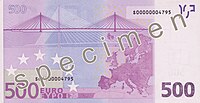500 euro note
| (Eurozone and Institutions) | |
|---|---|
| Value | 500 euro |
| Width | 160 mm |
| Height | 82 mm |
| Security features | Hologram patch with perforations, EURion constellation, watermarks, microprinting, ultraviolet ink, raised printing, security thread, matted surface, see through number, colour-changing ink, barcodes and serial number |
| Paper type | Cotton fibre |
| Years of printing | 1999–2014 |
| Obverse | |
 |
|
| Design | Window in Modern architecture |
| Designer | Robert Kalina |
| Design date | 3 December 1996 |
| Reverse | |
 |
|
| Design | Bridge in Modern architecture and map of Europe. |
| Designer | Robert Kalina |
| Design date | 3 December 1996 |
The five hundred euro note (€500) is the highest-value euro banknote and has been used since the introduction of the euro (in its cash form) in 2002. It is one of the highest-value circulating banknotes in the world, worth around 532 USD, 3,672 CNY, 60,931 JPY, 537 CHF or 437 GBP. The note is used in the 23 countries which have the euro as their sole currency (with 22 legally adopting it), with a population of about 338 million.
It is the largest note measuring 160 × 82 mm and has a purple colour scheme. The five hundred euro banknotes depict bridges and arches/doorways in modern architecture (around the late 20th century).
The five hundred euro note contains several complex security features such as watermarks, invisible ink, holograms and microprinting that make counterfeiting very difficult. Initially, the high denomination notes were introduced very rapidly so that in the first 7 years (up to December 2008) there were 530,064,413 five hundred euro banknotes in circulation. Subsequently, the rate of increase was radically slowed. In January 2016 there were 611,833,416 in circulation.
The European Central Bank announced on 4 May 2016 that it would phase out the 500 euro note by the end of 2018. “Authorities increasingly suspect that they (€500 notes) are being used for illegal purposes, an argument that we can no longer ignore,” according to a high-ranking bank official, Benoît Cœuré.
The euro was founded on 1 January 1999, when it became the currency of over 300 million people in Europe. For the first three years of its existence it was an invisible currency, only used in accountancy. Euro cash was not introduced until 1 January 2002, when it replaced the national banknotes and coins of the countries in eurozone 12, such as the Luxembourgish franc.
Slovenia joined the Eurozone in 2007,Cyprus and Malta in 2008,Slovakia in 2009,Estonia in 2011,Latvia in 2014 and Lithuania joined on 1 January 2015.
...
Wikipedia
